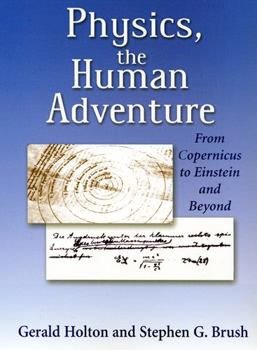Physics, the Human Adventure: From Copernicus to Einstein and Beyond
Select Format
Select Condition 
Book Overview
Winner of the 2001 Joseph Hazen Education Prize of the History of Science Society
Physics, the Human Adventure is the third edition of the classic text Introduction to Concepts and Theories in Physical Science. Authored by Gerald Holton, the text was a landmark in science education. It was the first modern textbook in physics (or in any other science) to make full and effective use of the history and philosophy of science in presenting for both the general and the science-oriented student an account of the nature of physical science. A second edition, prepared by Stephen G. Brush, brought the book up to date by increasing the coverage of topics in modern physics and by taking account of recent scholarly research in the history of science. In the new book Physics, The Human Adventure, each of the chapters has been reworked to further clarify the physics concepts and to incorporate recent physical advances and research. The book shows the unifying power of science by bringing in connections to chemistry, astronomy, and geoscience. In short, the aid of the new edition is to teach good physics while presenting physical science as a human adventure that has become a major force in our civilization. New chapters discuss theories of the origin of the solar system and the expanding universe; fission, fusion, and the Big Bang-Steady State Controversy; and thematic elements and styles in scientific thought. New topics include:- Theories of vision: does the eye send out rays or receive them?
- Distances in the solar system
- The prediction of the return of Halley's comet and analysis of deviations from Kepler's laws
- Angular momentum conservation and Laplace's nebular hypothesis
- Relation between symmetries and conservation laws: Emmy Noether's theorem
- First estimates of atomic sizes
- Consequences of the indistinguishability of elementary particles of the same kind
- Applications of quantum mechanics to many-particle systems
- Dirac's prediction of anti-matter
- The anthropic principle and other controversial issues on the frontiers of research
Format:Paperback
Language:English
ISBN:0813529085
ISBN13:9780813529080
Release Date:March 2001
Publisher:Rutgers University Press
Length:598 Pages
Weight:1.38 lbs.
Dimensions:1.2" x 7.1" x 10.1"
Age Range:18 years and up
Grade Range:Postsecondary and higher
Customer Reviews
1 rating
THE BEST introduction to physics concepts and history
Published by Thriftbooks.com User , 21 years ago
Having studied Holton's Harvard Project Physics textbook as a senior in high school thirty years ago, I was delighted to find this updated textbook by Holton and Brush. I have used Physics, The Human Adventure several times as one of the textbooks for an entry level Introduction to Physics college course that I teach occasionally here at the University of North Florida. (The second textbook for the class, which I believe complements Holton and Brush nicely, is College Physics in the Schaum's Outline Series). Physics, The Human Adventure is excellent! The book brings a mature, historical and philosophical orientation to the presentation of physics concepts. The history and philosophy weaves the development of the physics concepts without ever eclipsing the physics. I have found serious students love the book. The book does not try to present basic physics without utilizing mathematics, but the level of the mathematics is basic algebra and elementary trignonometry. Since most of my students are taking the course as background for continuing in their physics studies in algebra- or calculus-based physics courses, they appreciate the combination of Holton & Brush with the Schaum's outline textbook mentioned above. The students who are in the class for general education purposes are also well served by Holton and Brush; and it doesn't hurt them to work a half-dozen or so homework problems a week out of Schaum's, either. My highest compliment is, often I find myself picking up Holton and Brush just for the fun of it. I can't think of many other physics textbook that illicits this response from me! My only criticism is, in the early chapter introducing kinematics, the authors use speed and velocity in a way that deviates from current usuage. Also, it is standard now to use "g" to represent the (always) positive number 9.8 m/s/s.The authors use g=-9.8 m/s/s/, which is rare indeed. Admittedly, these are minor (if not trivial) matters. I highly recommend this textbook for conceptual/introductory physics courses or for anyone who is interested in physics principles via the history and philosophy of science. This textbook is head and shoulders above most of its competitors and I recommend it for use in courses primarily emphasizing the historical background of physics. (I hope Rutgers Press keeps this book in print!)





